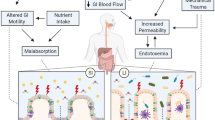Abstract
Some athletes suffer from exercise-induced gastrointestinal (GI) disturbances. We developed a profile of GI parameters in 10 symptomatic and 10 asymptomatic athletes both at rest and during exercise. Exercise included 90 min of cycling and running at 70% of maximal power. We measured oesophageal motility, gastro-oesophageal reflux, gastric emptying, orocaecal transit time (OCTT), intestinal permeability and intestinal glucose absorption. During cycling the number and duration of refluxes were increased, whereas gastric emptying showed no differences between rest, cycling and running. The OCTT was increased in the running trial, compared to rest (P=0.005). Also, intestinal permeability was higher in the running trial, compared to rest (P=0.008). There were no differences in intestinal glucose absorption between rest and exercise. Compared with asymptomatic athletes the symptomatic subjects had a higher intestinal permeability (P=0.001), more reflux episodes (P=0.03) and a longer duration of reflux (P<0.05) during cycling. No differences were observed at rest. In conclusion, there is no difference in GI profile between symptomatic and asymptomatic athletes at rest. During exercise, symptomatic subjects have a longer OCTT and a higher intestinal permeability, which is more pronounced during running than during cycling.


Similar content being viewed by others
References
Brouns F (1991) Etiology of gastrointestinal disturbances during endurance events. Scand J Med Sci Sports1:66–77
Brouns F (1998) Gastric emptying as a regulatory factor in fluid uptake. Int J Sports Med 19[Suppl 2]: S125-S128
Bulkley GB, Kvietys PR, Parks DA, Perry MA, Granger DN (1985) Relationship of blood flow and oxygen consumption to ischemic injury in the canine small intestine. Gastroenterology 89:852–857
Konturek S, Falser J, Obtulowicz W (1973) Effect of exercise on gastrointestinal secretions. J Appl Physiol 34:324–328
Kuipers H, Verstappen FTJ, Keizer HA, Geurten P, van Kranenburg G (1985) Variability of aerobic performance in the laboratory and its physiologic correlates. Int J Sports Med 6:197–201
Levitt MD (1969) Production and excretion of hydrogen gas in man. N Engl J Med 281:122–127
Peters HP, Bos M, Seebregts L, Akkermans LM, van Berge Henegouwen GP, Bol E, Mosterd WL, de Vries WR (1999) Gastrointestinal symptoms in long-distance runners, cyclists, and triathletes: prevalence, medication, and etiology. Am J Gastroenterol 94:1570–1581
Rooyakkers DR, van Eijk HM, Deutz NEP (1996) Simple and sensitive multi-sugar-probe gut permeability test by high-performance liquid chromatography with fluorescence labelling. J Chromatogr A 730:99–105
Van Nieuwenhoven MA, Wagenmakers AJM, Brouns F, Brummer RJM (1997) Effect of mode of administration of [13C]-acetate on [13C]-appearance in breath: implications for the gastric emptying breath test. Gastroenterology 112: A843
Van Nieuwenhoven MA, Brouns F, Brummer RJM (1999a) The effect of physical exercise on parameters of gastrointestinal function. Neurogastroenterol Mot 11:431–439
Van Nieuwenhoven MA, Wagenmakers AJM, Senden JMG, Brouns F, Brummer RJM (1999b) Performance of the [13C]-acetate gastric emptying breath test during physical exercise. Eur J Clin Invest 29:922–928
Van Nieuwenhoven MA, Vriens BEPJ, Brummer RJM, Brouns F (2000) Effect of dehydration on gastrointestinal function at rest and during exercise in humans. Eur J Appl Physiol 83:578–584
Wade OL, Combes B, Chilos AW (1956) The effect of exercise on the splanchnic blood flow and splanchnic blood volume in normal men. Clin Sci 15:457–463
Winne D (1984) Models of the relationship between drug absorption and the intestinal blood flow. In: Shepherd AP, Granger DN (eds) Physiology of intestinal circulation. Raven Press, New York, p 289
Wolfe RR (1992) Radioactive and stable isotope tracers in biomedicine. Wiley, New York
Author information
Authors and Affiliations
Corresponding author
Rights and permissions
About this article
Cite this article
van Nieuwenhoven, M.A., Brouns, F. & Brummer, RJ.M. Gastrointestinal profile of symptomatic athletes at rest and during physical exercise. Eur J Appl Physiol 91, 429–434 (2004). https://doi.org/10.1007/s00421-003-1007-z
Accepted:
Published:
Issue Date:
DOI: https://doi.org/10.1007/s00421-003-1007-z




